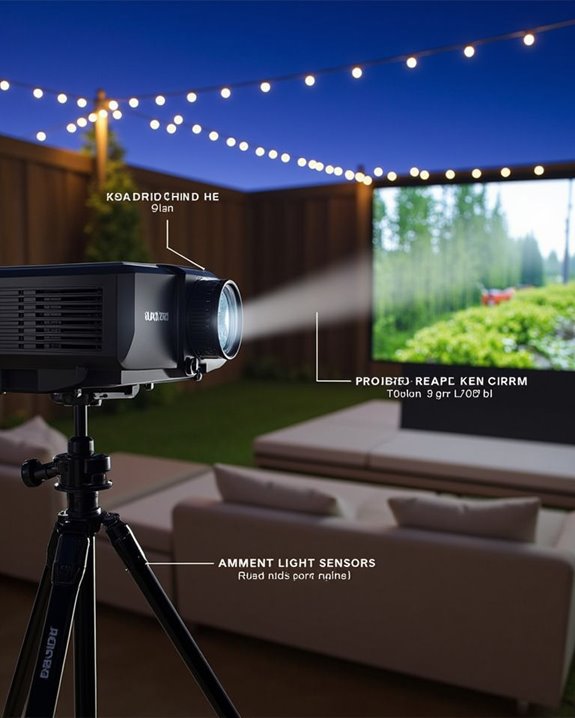When selecting an outdoor projector, you need to focus on several key factors, starting with brightness levels of at least 2,500 ANSI lumens to guarantee visibility in daylight, and a minimum resolution of 1080p for clear visuals, ideally with HDR support for color accuracy. It’s important to assess wireless connectivity options like Wi-Fi and Bluetooth, while also considering rugged, weather-resistant designs for reliable outdoor use, but understanding sound and compatibility needs is equally vital.
Key Takeaways
- Choose a projector with at least 2000 ANSI lumens for clear images in outdoor lighting conditions.
- Prioritize models with wireless connectivity (Wi-Fi, Bluetooth) for flexible and cable-free outdoor setups.
- Select a projector with at least 1080p resolution and support for HDR for vivid, sharp visuals.
- Look for durable, weather-resistant designs and portable features for easy and safe outdoor use.
- Ensure compatibility with various devices and external speakers for versatile content and powerful audio.
Brightness and Performance
When you’re choosing an outdoor projector, brightness and performance are two of the most essential factors to contemplate, since the amount of light in your environment can dramatically affect what you see on the screen. You’ll want to focus on projectors with high lumens—at least 2000-2500 ANSI lumens for daylight or larger screens—so your images remain visible even in bright conditions. For nighttime or shaded areas, 1500-2500 lumens typically suffice. Color accuracy is vital because outdoor lighting can distort true colors, so select models known for precise color reproduction. Choosing a projector with high contrast ratios also helps maintain image depth and vibrancy under varied lighting conditions. For large or bright outdoor events, 6000+ ANSI lumens are recommended to ensure vibrant and clear visuals even on expansive screens. Energy efficiency should also be considered, especially for longer events, as it impacts both operational costs and projector longevity. Technologies like higher contrast ratios and laser light sources further enhance brightness and overall performance in various outdoor settings.
Resolution and Display Quality
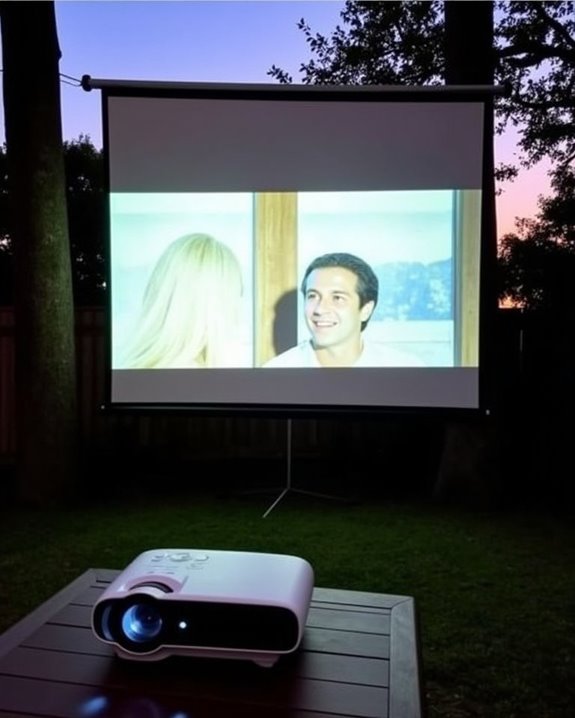
Although brightness is essential for visibility, resolution and display quality are equally important when selecting an outdoor projector, as they determine how sharp and lifelike your images appear on the screen. Higher resolution means greater pixel density, so a4K projector, offering 3840×2160 pixels, provides exceptionally crisp images, while 1080p (1920×1080 pixels) remains a popular, budget-friendly choice for outdoor movie nights. Entry-level 720p models, with fewer pixels, are best suited for small screens and basic needs. Color accuracy is critical, especially outdoors, where ambient light can distort image tones—projectors with a wide color gamut and strong contrast ratio deliver more vivid, realistic visuals. For ideal results, match your projector’s resolution and display quality to your screen size, content quality, and viewing preferences. Many top models also support HDR10 and HDR, enhancing contrast and color vibrancy for outdoor viewing. Matching the projector resolution to your intended content and viewing environment ensures you get the best possible image clarity and detail for your outdoor setup.
Portability and Outdoor Design
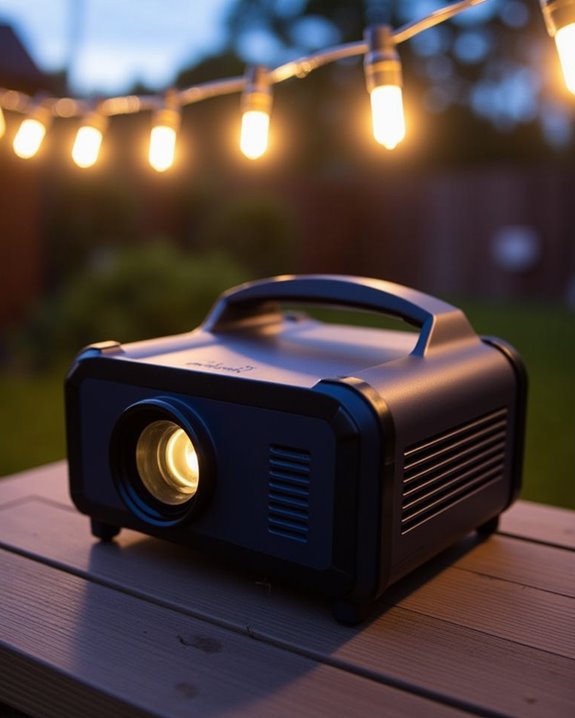
Curious about what makes an outdoor projector truly practical for open-air settings? Portability and outdoor design are essential factors to consider when selecting a projector for diverse environments. Lightweight projectors with compact dimensions, portable cases, and carrying handles allow you to move your device effortlessly between backyards, parks, and campsites. Rugged construction, including water and dust resistance, ensures reliable performance even when exposed to unpredictable outdoor conditions. Many outdoor projectors also feature built-in batteries for cordless operation and integrated stands for simplified setup. When projecting outside, ambient lighting can wash out images, so choosing a projector with features that help maintain image clarity is crucial. Additionally, selecting projectors with brightness levels tailored to outdoor lighting conditions significantly enhances viewing quality. To maximize practicality and protection, look for these features:
- Durable, weather-resistant housings
- Drop resistance of at least 0.5 meters
- IPX2 or higher water resistance rating
- Portable cases for accessory organization
- Integrated controls for quick, outdoor-friendly operation
These elements ensure your projector stands up to outdoor demands.
Sound and Audio Capabilities
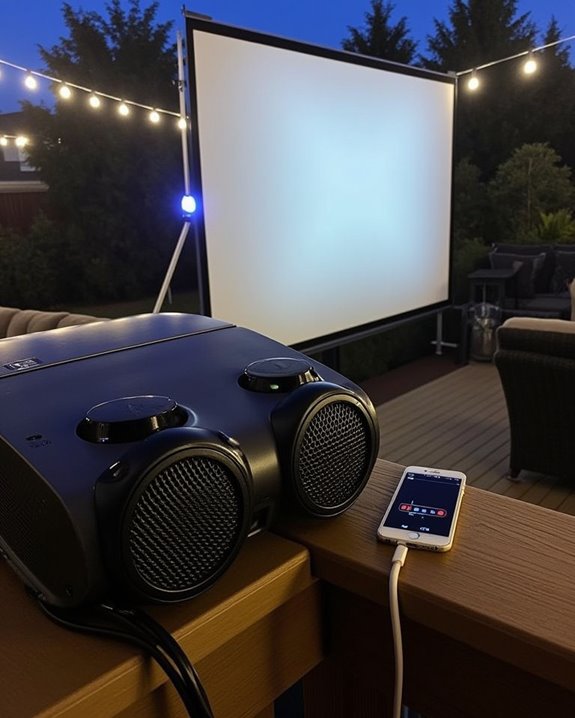
Selecting the right sound and audio capabilities is essential for outdoor projector setups, since open-air environments introduce unique challenges that affect both volume and clarity. Outdoor setups require higher sound amplification than indoor spaces, as sound dissipates quickly without walls to reflect it and ambient noise can overpower weaker audio systems. For effective coverage, you’ll want at least 60 watts per speaker for small areas, scaling up to 175 watts for larger spaces, ensuring distortion-free audio even during cinematic peaks. While some projectors offer built-in speakers, these typically lack the power and range needed for immersive surround sound outdoors, making external, weather-resistant speaker systems preferable. Integrating robust external speakers extends sound coverage, maintains audio clarity, and delivers a true cinematic experience across your entire outdoor seating area. Many premium outdoor projector packages, like the QuikScreen Series, come equipped with powerful 400-watt or even 800-watt Bluetooth audio systems specifically designed to meet the demands of outdoor events.
Content Compatibility and Connectivity
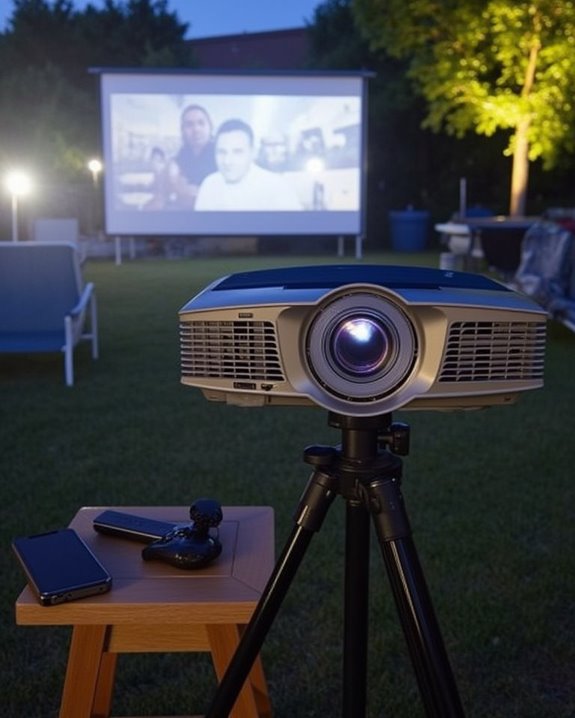
When you’re setting up an outdoor projector, ensuring robust content compatibility and versatile connectivity is essential for a seamless viewing experience, as these features determine which types of media you can display and how easily devices connect. Look for projectors that support a wide range of video formats like MP4, AVI, and MKV, allowing you to play most downloaded or personal videos. Subtitle support is critical for accessibility, especially when watching foreign films or in noisy outdoor environments. Wireless streaming, enabled through WiFi, lets you access content from platforms like Netflix or YouTube without extra devices. Outdoor projectors with high brightness, measured in lumens, are also crucial for maintaining image clarity during daytime use, especially in well-lit or partially shaded environments. All-encompassing connectivity, such as HDMI, USB, and Bluetooth, allows easy input from multiple sources. Prioritize these features:
- Multiple video, audio, and image format compatibility
- Built-in wireless streaming capability
- Reliable subtitle support
- Wide device connectivity (HDMI, USB, Bluetooth)
- Smart platform integration for direct app access
Budget and Value Considerations
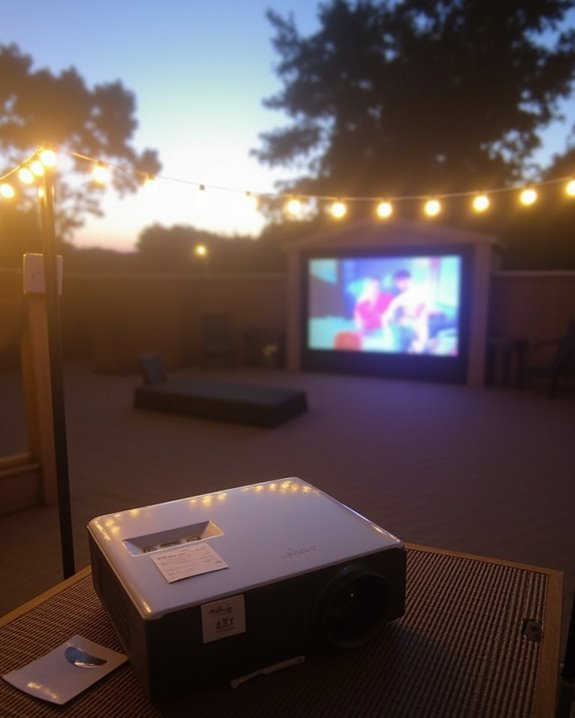
Alongside connectivity and content compatibility, budget and value considerations play a significant role in choosing the right outdoor projector, as price directly affects the features, performance, and convenience you can expect. Pricing trends show budget models typically range from $300 to $500, offering 1080p resolution and around 800 lumens, which is sufficient for low-light conditions but may struggle in brighter environments. As you explore different options, examining brand reputation helps guarantee reliability, as established brands often provide better support and consistent quality. Premium projectors, often above $1,000, include enhancements such as 4K resolution, higher brightness, and longer battery life, but also demand a higher investment. Balancing essential features like brightness, portability, and power options against your budget guarantees the best value for your specific outdoor viewing needs. Many budget outdoor projectors now come equipped with wireless connectivity options like Wi-Fi and Bluetooth, which can enhance flexibility and reduce setup complexity for outdoor use.
Frequently Asked Questions
How Do I Protect My Projector From Rain or Sudden Weather Changes?
If you’re worried about rain or sudden weather changes, use protective covers and follow weatherproofing tips like placing the projector in a sheltered spot or weatherproof enclosure. Always monitor forecasts and have a quick disconnection plan ready.
Can Outdoor Projectors Be Used for Backyard Poolside Movie Nights?
Did you know that 65% of homeowners host poolside entertainment? You can absolutely use outdoor projectors for backyard poolside movie nights—just guarantee they’ve got waterproof features or protection, and you’ll enjoy crisp, immersive viewing even outdoors.
Are Outdoor Projectors Safe to Leave Outside Overnight?
You shouldn’t leave outdoor projectors outside overnight unless they’re protected—weather, temperature swings, and theft risks make it unsafe. Proper projector placement and managing ambient lighting won’t matter if moisture or security issues damage your equipment.
What Maintenance Is Required for Outdoor Projectors?
You’ll need to clean filters and the lens regularly, wipe the exterior gently, and replace the bulb as needed. Don’t forget to check cooling systems and store your projector safely to prevent dirt, moisture, and damage.
How Do I Prevent Bugs From Being Attracted to the Projector Light?
If you’d rather not invite extra “guests” to your movie night, use bug prevention strategies and light deterrents. Opt for warm or red lights, minimize UV, direct beams downward, and keep the area tidy for best results.

